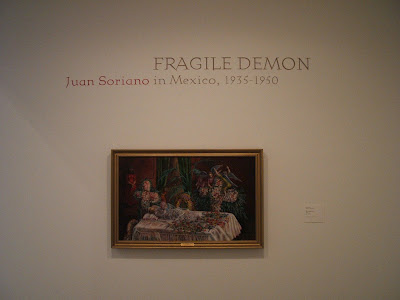
Walking through the galleries of the PMA’s Frida Kahlo exhibition at the press preview last Friday, I actually could feel the presence of the artist. Perhaps it was the amazing collection of personal photographs that serve as a powerful prologue to the paintings. Looking at a photo of Diego Rivera and then being able to see the other side, upon which Frida placed a heavily lipsticked kiss, I sensed the more than five decades since her death in 1954 melt away. Of course, looking at the paintings, so many of them self-portraits, such as her masterpiece, The Two Fridas (above, shown in the United States for the very first time), you find it easy to believe that you know the artist like a beloved old friend.

Co-curators Elizabeth Carpenter (above, explaining Kahlo’s Portrait of Luther Burbank) and Hayden Herrera led the tour through the galleries. The PMA’s own modern art curator Michael Taylor introduced the tour by pointing out the choice of wall colors for the exhibition. The early works begin surrounded by blue walls, much like the famous Blue House of Frida’s childhood, featured prominently in several of the paintings. Blue gives way to deep, blood red in the rooms housing the more tortured, intimate works such as The Two Fridas. It’s hard to imagine a more comprehensive collection of Kahlo’s work assembled than this one, which makes it a must-see for anyone interested in her life or the trajectory of modern art, especially the role of women in that history still being written.

The preview provided yet another chance to hear Hayden Herrera (above, with Michael Taylor looking on) speak upon the subject that her biography helped launch into the consciousness of mainstream culture. I found it fascinating that Herrera confessed that she herself had never seen many of the paintings in person until this exhibition. When she mentioned that she had never seen the gouges in the frame of A Few Small Nips, engraved by Frida during a moment of Diego-inspired fury, it heavily impressed on me that even such “well-known” artists as Kahlo remain a never-ending source of revelations even for authorities such as Herrera.
Perhaps the greatest revelation of the exhibition to me was the sheer physicality of the works, or their lack of it. With the exception of The Two Fridas, most of the works are relatively small in size, understandable considering that Kahlo painted many of them while convalescing in bed from injuries or her innumerable surgeries. The tininess of these works draws you in, pulling you into the artist’s embrace. Her choice of materials, such as metal supports to mimic the ex voto of Mexican folk art, becomes clearer through the PMA’s presentation of ex votos in their own collection. An 1803 ex voto of a woman and child surviving a fall from a balcony (above) recreates the context Kahlo worked within wonderfully when hung close by The Suicide of Dorothy Hale, the surreal portrait of the dead actress and perhaps Frida’s most wonderfully bizarre ex voto.
This exhibition showcases the PMA’s special interest in Mexican and Latin American art. All of the signage appears in both English and Spanish in anticipation of a heavy Hispanic audience (such as the text beside The Broken Column above). In support of the exhibition, the PMA created a side show of Frida Kahlo in Context, featuring works by her Mexican contemporaries David Alfaro Siqueiros, Federico Cantu, Dr. Atl, her beloved Diego, and many others. The gift shop offers the obligatory kitsch, but kitsch with a specific flavor. The tiny doll of Frida as seen in The Broken Column and the ready-to-display Frida shrine were personal favorites for their capturing of the baroque nature and black humor of Mexican spirituality. It will be interesting to see just how many people buy into and literally buy the more Frida-esque items versus the safer t-shirts, scarves, and prints.
Another great extra-Frida touch is the Juan Soriano exhibition, Fragile Demon: Juan Soriano in Mexico, 1935 to 1950 (the exhibition title and The Dead Girl [1944] shown above). Soriano knew Kahlo, who was 13 years older. Although they came from slightly different generations, the same Mexican and modernist drives inform their work. The PMA’s exhibition shows Soriano’s work in the United States for the first time, bringing this well-known name in Mexico to an American audience perhaps primed by the Kahlo show for further explorations into Mexican and Latin American art. (I’ll be running a review of the Soriano catalogue soon.)
Although this exhibition previously appeared at the Walker Art Center and will later travel to the SFMoMA, I doubt either can replicate the experience the PMA offers with their own supporting collections (both of the ex votos and pre-Columbian art, which appears often in late works by Kahlo, such as My Nurse and I), the Kahlo in Context gallery, and the Soriano show. Hopefully, people in Philadelphia and even New York and Washington, D.C., will realize the opportunity the PMA is offering and take full advantage of coming face to face with Frida and her world.
[Many thanks to the PMA for inviting me to the Frida Kahlo press preview.]







No comments:
Post a Comment